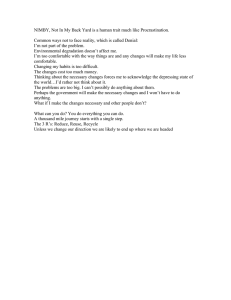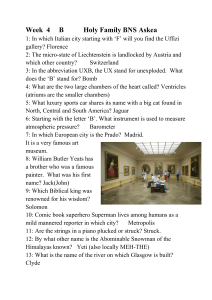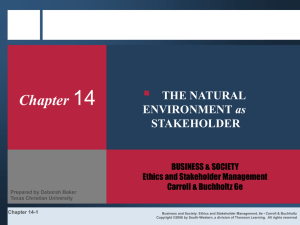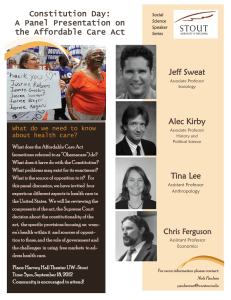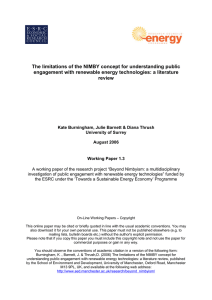Jacob Glickel
advertisement
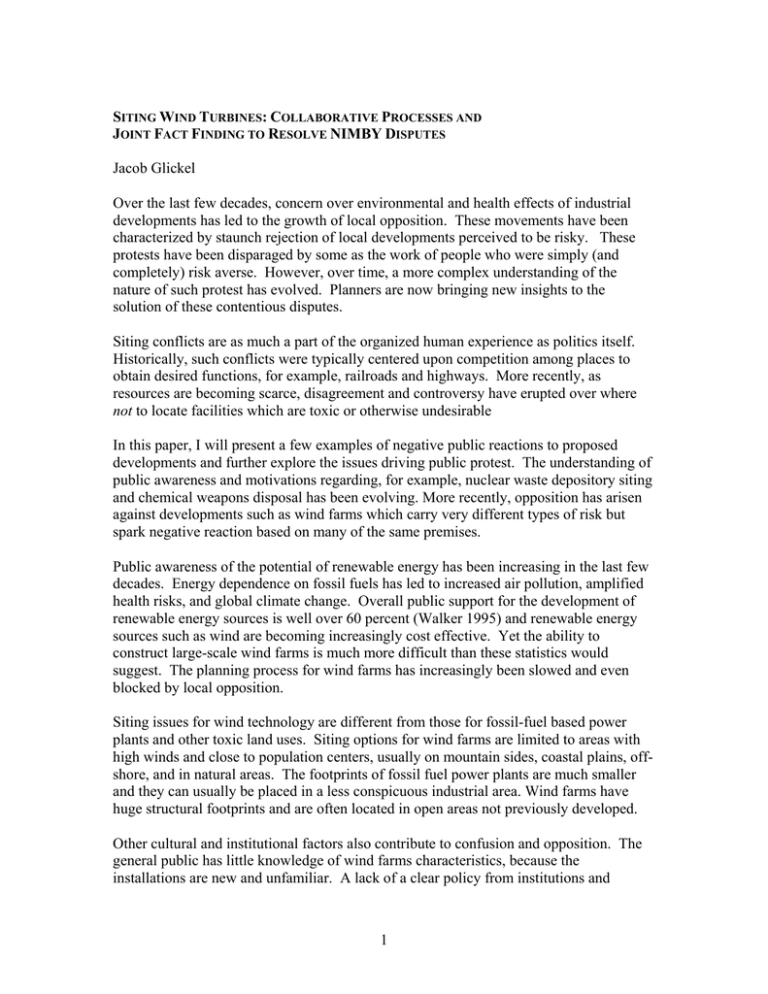
SITING WIND TURBINES: COLLABORATIVE PROCESSES AND JOINT FACT FINDING TO RESOLVE NIMBY DISPUTES Jacob Glickel Over the last few decades, concern over environmental and health effects of industrial developments has led to the growth of local opposition. These movements have been characterized by staunch rejection of local developments perceived to be risky. These protests have been disparaged by some as the work of people who were simply (and completely) risk averse. However, over time, a more complex understanding of the nature of such protest has evolved. Planners are now bringing new insights to the solution of these contentious disputes. Siting conflicts are as much a part of the organized human experience as politics itself. Historically, such conflicts were typically centered upon competition among places to obtain desired functions, for example, railroads and highways. More recently, as resources are becoming scarce, disagreement and controversy have erupted over where not to locate facilities which are toxic or otherwise undesirable In this paper, I will present a few examples of negative public reactions to proposed developments and further explore the issues driving public protest. The understanding of public awareness and motivations regarding, for example, nuclear waste depository siting and chemical weapons disposal has been evolving. More recently, opposition has arisen against developments such as wind farms which carry very different types of risk but spark negative reaction based on many of the same premises. Public awareness of the potential of renewable energy has been increasing in the last few decades. Energy dependence on fossil fuels has led to increased air pollution, amplified health risks, and global climate change. Overall public support for the development of renewable energy sources is well over 60 percent (Walker 1995) and renewable energy sources such as wind are becoming increasingly cost effective. Yet the ability to construct large-scale wind farms is much more difficult than these statistics would suggest. The planning process for wind farms has increasingly been slowed and even blocked by local opposition. Siting issues for wind technology are different from those for fossil-fuel based power plants and other toxic land uses. Siting options for wind farms are limited to areas with high winds and close to population centers, usually on mountain sides, coastal plains, offshore, and in natural areas. The footprints of fossil fuel power plants are much smaller and they can usually be placed in a less conspicuous industrial area. Wind farms have huge structural footprints and are often located in open areas not previously developed. Other cultural and institutional factors also contribute to confusion and opposition. The general public has little knowledge of wind farms characteristics, because the installations are new and unfamiliar. A lack of a clear policy from institutions and 1 regulators has added to the confusion. A review of the dynamics of traditional NIMBY cases will illuminate the development of public opposition to wind energy. Characteristics of NIMBY Disputes Researchers have developed three main theories to explain the NIMBY response to perceived or actual risks: The public is either ignorant or irrational, selfish, or prudent (Freudenburg and Pastor 1995). The initial definition of the NIMBY syndrome characterized the public response as irrational and uneducated. This perspective characterizes the public as unwilling to accept any risk at all for the benefit of society. Proponents of this theory conclude that the public is uninformed and thus unreasonable. The argument doesn’t recognized that issues of uncertainty will always be a part of any decision dealing with impacts on the natural world. Both experts and citizens are bound by the same principles of assessment, which include uncertainty, and are thus put in the position of making a “judgment call.” Public selfishness is legitimized in a free-enterprise economic model which is based on the assumption that it is inherently rational for individuals to look out for their own interests. Researchers have the difficult task of determining which self-interested attitudes are justified and which aren’t. For instance, while it may be simple to measure the potential response of property values to proposed alterations in land use, it is difficult to quantify and weigh wide-spread public benefit from a development. More recent research has recognized some public opposition as prudent and valuable to a complete impact assessment. Organized protest challenging science-based assessments can uncover elements of the “big picture” scientists might otherwise not consider. Furthermore, there is much to be gained by going beyond either blaming or understanding specific opposing views to an understanding of the broader system that creates opposition in the first place. In addition to providing a gauge for appropriate compensation from beneficiaries of a project to the affected communities, this perspective can enable institutions and agencies to reconsider the basis for their credibility in communities. Erosion of Social Trust Roger Kasperson et al. (1992) explore the erosion of social trust in policy makers and discuss how this has influenced local opposition to projects. Social distrust is a “person’s expectation that other people and institutions in a social relationship are likely to act in ways that are incompetent, unpredictable, uncaring and thus probably inimical” (Kasperson et al. 1992). This research shows that in the past three decades there has been a broad-based loss of trust in leaders of major social institutions in the US. Of the multiple causes of this phenomenon, the two most important are the increasing complexity of the issues, and a rising demand that resources be directed toward the common good. The growing demand for environmental, health, and safety protections has strained these available resources. These factors underlie the proliferation of NIMBY 2 responses toward risks such as those perceived in the siting of hazardous waste facilities. The collision of technological complexity and the need for new land uses provokes the NIMBY response. Deconstructing NIMBY Deconstructing the NIMBY syndrome of confusion and distrust should enable community members, developers, and agencies to avoid stalemates and reach toward mutually satisfactory solutions to siting issues. This section further defines NIMBY and uses a case example to demonstrate some of its essential elements. The basic construct of a NIMBY dispute is the emotional reaction of people faced with a threat to their community. More intense emotional response will provoke higher levels of opposition. NIMBY exponents lack trust and confidence in project developers and sponsors. They believe that the interests of developers lie only within the project and not with its impacts on the local community. This distrust leads a community to discount risk information and eventually, if emotions persist, to an uncompromising position. Project experts and developers may respond by dismissing opposing perspectives and disrespect for community opposition (Kraft and Clary 1991). How do the reputation of the government agency involved, its approach to community concerns, and its record of performance affect the level of response? Michael Kraft and Bruce Clary (1991) conducted an analysis of opposition to the Nuclear Waste Repository (high level radioactive waste storage) siting led by the US Department of Energy (DOE) to determine if it was a true NIMBY response. While the survey didn’t indicate a pure NIMBY reaction, several factors were suggestive. Significantly, the perception of risk from the project (though not in general) on the part of opposing witnesses were higher than that expressed by the experts. Kraft and Clary’s analysis of the testimony shows no predictable measures of opposition, mainly because they did not sort out a number of complex variables. Witnesses strongly opposed any repository siting, especially in their local communities. Yet the citizens who testified were well informed about the technical characteristics of the facility and demonstrated a broader knowledge of the topics under discussion than did the DOE representatives. Reframing NIMBY A broader understanding of how NIMBY develops reveals how it adapts to obstacles. The credibility of an institution, such as a federal agency, can have a significant effect on how the opposition organizes. Understanding and achieving the elements of “credibility” can help an agency, or other group, gain the confidence of a community and move beyond NIMBY. Social protests against local developments such as nuclear power plants are not necessarily based on the same ideas as other NIMBY actions. However, accounts of early stages of protest, regardless of object, indicate a similar cognitive shift. According to Robert Futrell (2003), true NIMBY reactions include a “shift in awareness based on a 3 sense of injustice and obligations to act.” Active resistance doesn’t form immediately but once formed it persists until the dispute is resolved in one manner or the other Futrell provides a case study of a chemical weapons disposal dispute which began in 1984. The US Army declared their existing stockpile obsolete and announced that it would begin disposal through incineration. Abiding by US law, the Army conducted an environmental impact statement (EIS) for its eight disposal sites. To comply with the EIS, the Army held public meetings to involve the local communities in the process. The meetings produced little interest except in Madison County, Kentucky. Locals asked the Army for information concerning safety of the chemical weapons incineration and possible alternatives. At this point there was no opposition to the process, but Army officials were not prepared to answer many of the initial questions. This led to growing concern among community members about the plans and increased concern that the Army was going to expose the community to toxic chemicals. A haze of confusion and anxiety developed into community opposition to incineration on the base. Continued presentations did not overcome the initial community fears and the possibility of moving the incineration to another site gained momentum among residents. To counter the opposition the Army reframed the debate by ruling out the possibility of transportation of the chemicals from the site and put the burden of proof on the opposition to support their claims that incineration was dangerous. Unable to support a credible claim of risk, the opposition soon lost its intensity. This reframing allowed for “cognitive liberation” (Futrell 2003) of local opposition. They did not have the resources to challenge the Army’s plans alone and tapped into the large anti-toxics movement. They were able to access experts who could document the effects of toxic chemicals. As knowledge increased, the local opposition to incineration was transformed into an even greater concern for having the toxic chemicals stored nearby. Wind Energy and Public Attitudes Public acceptability is increasingly seen as a constraint on the utilization of renewable energy, in which no toxic danger is involved. Electricity power plants have all the characteristics of contention-prone developments: They are large, intrusive, technically complex and perceived to pose serious, possibly irreversible environmental and health impacts. At the earlier stages of development, with environmental groups strongly advocating their use, renewable power plants were expected to produce far less opposition than traditional power plants. However, as large-scale renewable energy projects are being proposed more often, opposition has emerged. The planning process has increasingly had to accommodate the type of intense conflict and debate previously associated with the siting of hazardous facilities. Several renewable technologies, including geothermal, solar, hydro, wave biomass, and wind, have potential to reduce dependence on fossil fuels for energy. Geothermal and biomass facilities share the small footprint of traditional fossil fuel power plants. They use fuels to produce steam to turn a turbine and produce electricity. Solar cells can be 4 placed on roofs and hydro technology has been around long enough so that people are familiar with it. Wind power, however, is the option of greatest interest at present. It is currently more cost effective than solar and constitutes a huge resource for “clean” power. A number of surveys have been taken to determine public attitudes towards wind. In Walker (1995), a review of surveys showed a high proportion of positive views of wind farms in the abstract, indicating that respondents felt the facilities would have little impact on the surrounding environment. The public was especially positive about the development of small wind farms. Despite the overall positive views, specific wind farms are viewed less favorably than is the abstract idea of wind power. This is particularly significant because among these opponents are environmental activists. Wind turbines have been widely accepted once they are in place (Krohn and Damborg 1999). In a number of European surveys, people with a high degree of knowledge about renewable energy generation and wind turbines have a more favorable opinion of wind turbines than those with little knowledge. In a study done in Sydthy, Krohn and Damborg show that people’s attitudes towards wind turbines were not correlated to the distance between their homes and the turbines. In fact, those living closer (500 meters) had a more positive attitude than those living farther away. The study also finds that people living within a more densely populated area have a more negative impression than rural residents. City dwellers visiting the country seek unspoiled landscapes, while the rural inhabitants themselves want to use available resources including wind. According to Maarten Wolsink (2001), the range of common responses against or in favor of wind energy include: Against • Renewable energy cannot solve our energy problems. • Wind turbines are unreliable and expensive. • Wind turbines spoil the scenery and cause noise pollution. • Wind turbines kill birds. In Favor • Renewable energy is very much an alternative to other energy sources. • Climate change must be taken seriously. • Wind energy is limitless, non-polluting and safe. The finding that people overwhelmingly support wind energy in the abstract but object to specific local projects for various reasons is not a special feature of wind energy. The NIMBY syndrome is the same whether directed toward a highway, nuclear waste facility, or other generating plants. However, NIMBY in the case of wind energy reveals some interesting attitudinal elements. A number of studies (Bishop and Procter 1994) have demonstrated that local acceptance is high in reference to the abstract idea, low when discussing a specific local 5 development, and increases to higher levels after a project is complete. These surveys also indicate that levels of acceptance increase with knowledge. Areas where knowledge levels are low show increased NIMBY effect (Krohn and Damborg 1999). Wolsink (2000) does not agree that wind development is generally subject to NIMBY syndrome. While he acknowledges the huge gap between public acceptance of wind energy and the amount of installed capacity, Wolsink states that opposition stems from the process during the planning phase of a development. Typically, organizations and groups involved in planning issues are perceived to have fixed, static positions. In fact, public attitudes can be dynamic and changeable during the planning phase of a project, a factor which can be easily overlooked (Healey 1998). Although the attitudes may be personal, they are apparently dependent highly on the way physical planning is conducted. Simply put, the institutional and regulatory framework can create opposition just as effectively as NIMBY sentiment. Planners would do well to create a process that accommodates public attitudes early on. Complexity of Attitudes Walker (1995) and Thayer and Freeman (1987) point out that responses to wind farms depend on complex sets of perceptions, including the symbolic and physical. Some people acknowledge negative impacts, but consider these to be minor factors compared to the overall positive impacts of wind energy. Thayer and Freeman report a common positive response to the wind turbines in Altamont Pass, California based on “symbolic referential attributes not automatically associated with the visual stimuli. This group was willing to forgive the visual intrusion of the turbines on the landscape for the presumably higher goals of the project, whereas those opposed were not” (Thayer and Freeman (1987). Despite popular approval of wind farms, opposition to specific projects has been increasing in the US. According to Walker (1995) some opponents object that ● Sites to be developed have high value within the community. ● Wind farm proposals have developed rapidly with inadequate local consultation. ● Coordinated national planning policy is needed. Responding to these concerns will require a collaborative process to bring community concerns into the decision-making process. To minimize opposition, planners could involve the public more effectively, with special attention to extensive education about the risks and benefits of specific projects. Planners should consider altering large-scale development plans to include smaller-scale and community projects, and should develop ways to compensate the community. Given the lack of historical cases for reference in structuring community involvement in planning for wind turbines, planners are embarking on what might be a very steep learning curve, especially in the United States. These experiences should be mined to help smooth the way for planning future projects. Local opposition to development projects is increasingly changing the process. Undervaluation of the voice of the community is widely understood for hazardous local 6 siting. This is one of the common themes that those rejecting a wind energy project on NIMBY grounds share with other opposition movements. However, disputes over siting wind farms also include some unique elements, especially in relation to the environmental community. It is important to study these elements to ease the way for other forms of renewable energy as they become feasible for large-scale development. References Bishop and Proctor. 1994. Love them or loathe them? Public attitudes towards wind. Cardiff. Freudenburg, William and Susan Pastor. 1992. NIMBYs and LULUs: Stalking the syndromes. Journal of Social Issues 48 (4): 39-61. Futrell, Robert. 2003. Framing process, cognitive liberation, and NIMBY protest in the U.S. chemical-weapons disposal conflict. Sociological Inquiry 73 (3): 359-386. Healey, P. 1998. Building institutional capacity through collaborative approaches to urban planning. Environment and Planning A 30: 1531-1546. Innes, Judith and David Booher. 1999. Consensus building and complex adaptive systems: A framework for evaluating collaborative planning. Journal of American Planning Association 65 (4): 412-423. Kahn, Robert. 2000. Siting struggles: The unique challenge of permitting renewable energy power plants. Electricity Journal March: 21-33. Kasperson, Roger, Dominic Golding, and Seth Tuler. 1992. Social distrust as a factor in siting hazardous facilities and communicating risks. Journal of Social Issues 48 (4): 161187. Kraft, Michael and Bruce Clary. 1991. Citizen participation and the NIMBY syndrome: Public response to radioactive waste disposal. The Western Political Quarterly 44 (2): 299-328. Krohn, Soren and Steffen Damborg. 1999. On public attitudes towards wind power. Renewable Energy 16: 954-960. Thayer, R. and Freeman. 1987. Public perceptions of a wind energy landscape. Landscape and Urban Planning14: 373-398. Walker, Gordon. 1995. Renewable energy and the public. Land Use Policy 12 (1): 49-59. Wolisink, Maarten. 2000. Wind power and the NIMBY-myth: institutional capacity and the limited significance of public support. Renewable Energy 21: 49-64. 7 Wolisink, Maarten. 2001. Institutional Capacity for Spatial Implementation of Renewable Energy. Amsterdam: University of Amsterdam, Department of Geography and Planning. 8

